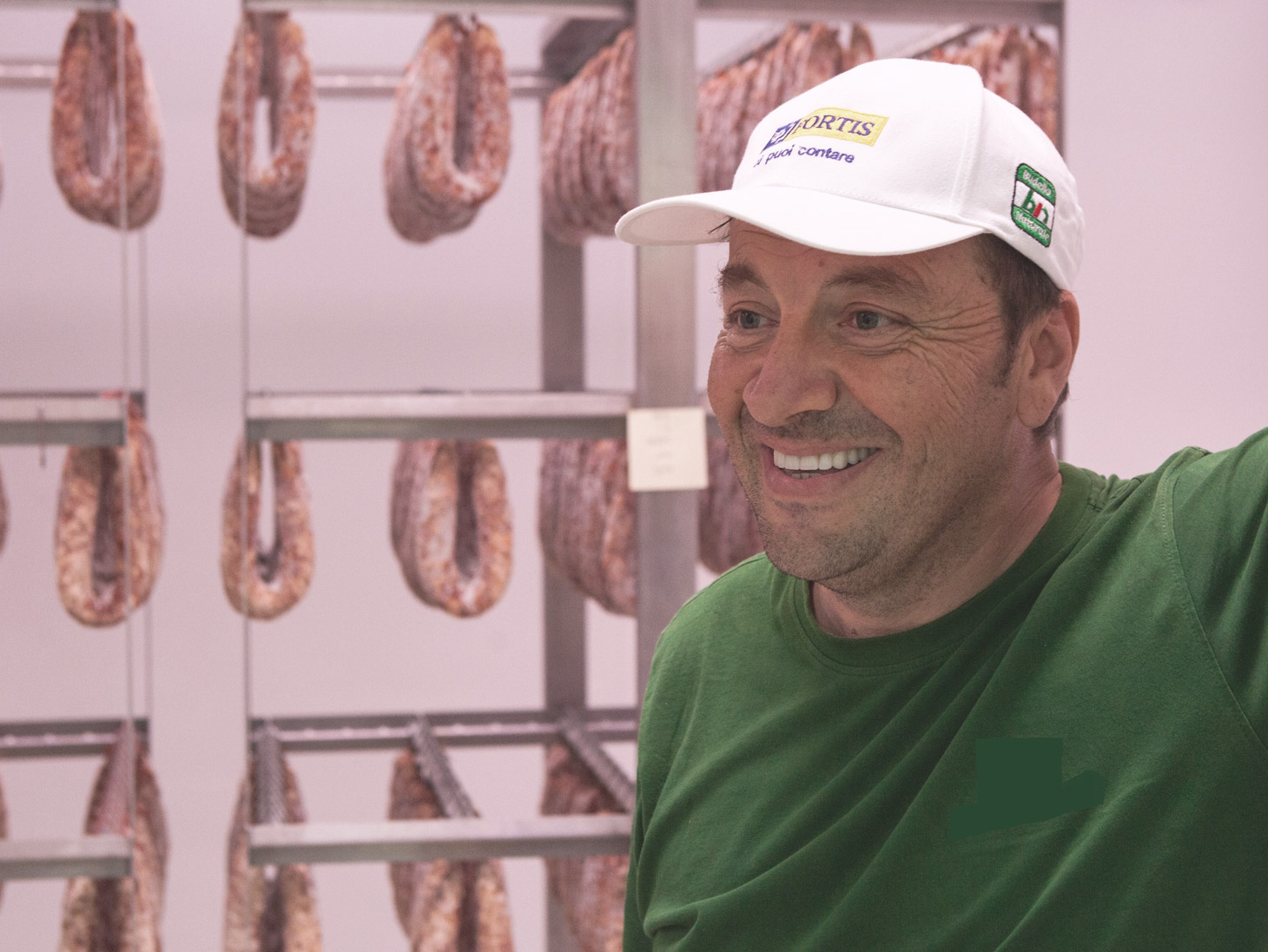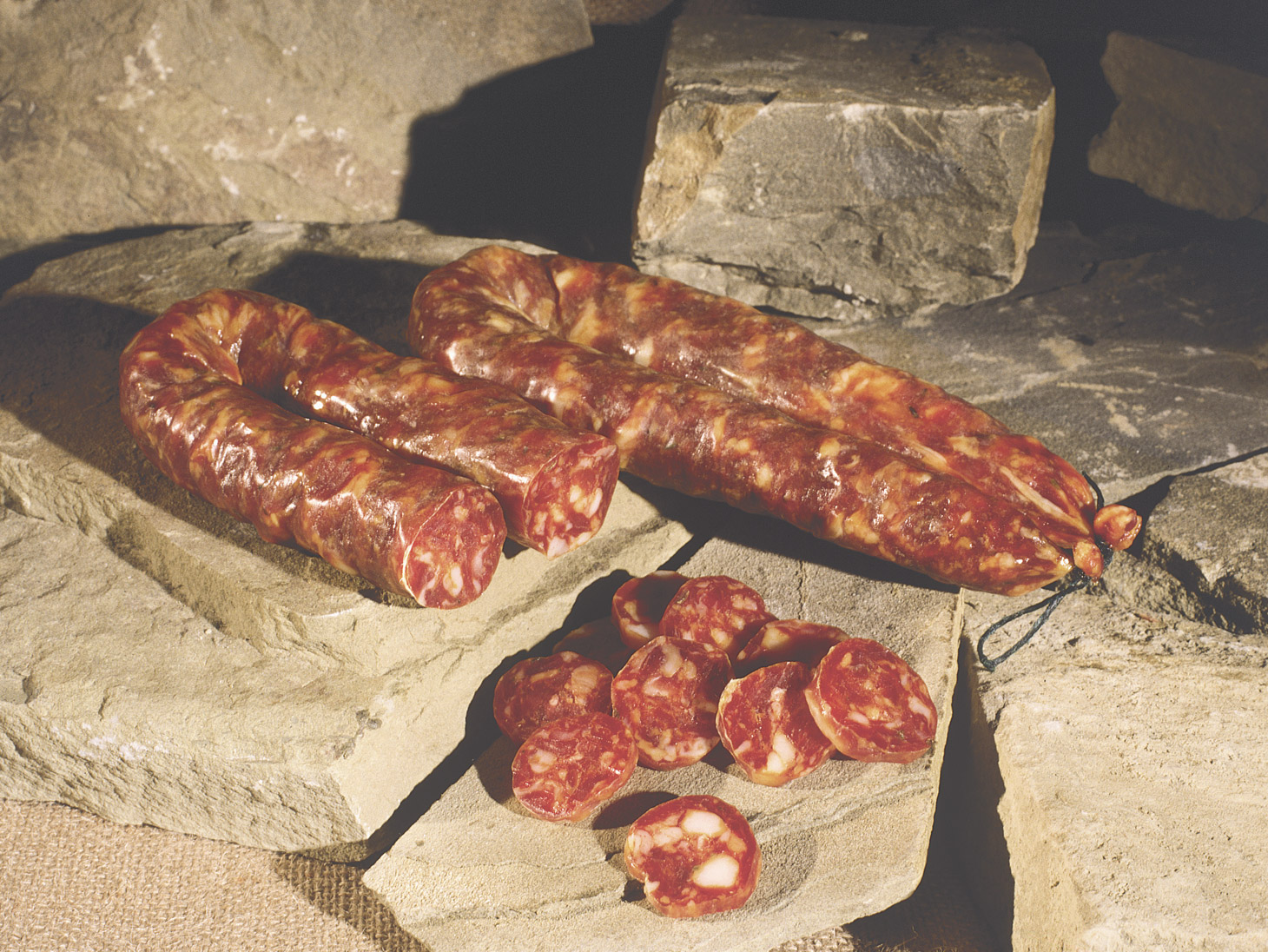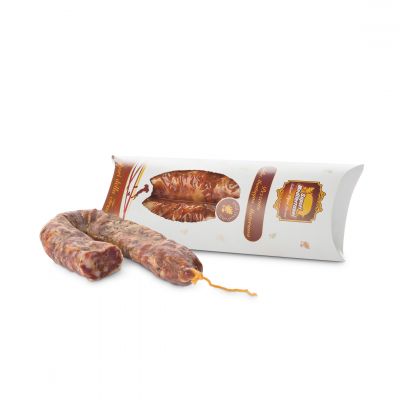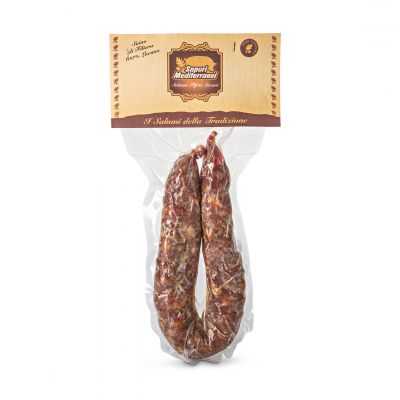
A small company called Sapori Mediterranei lies between the hills and mountains of Basilicata, near Cirigliano, in a tiny medieval village situated 656 metres above sea level. This company continues to artisanally produce cured meats with a millennia-old tradition, that were first produced in these areas. A tradition that dates back to ancient Roman times: according to the writings of Cicero and Varrone, the most famous sausage called the “Lucanica” or simply salsiccia (sausage), was invented right here in Lucania. “The Roman soldiers learned the art of making cured meats into sausages from the Lucanian slaves, and Apicius, Caesar’s gastronomist, perfected the recipe,” says Giovanni Ciliberti, the company’s owner. Just like the Roman soldiers, Giovanni also learned the ropes of pork butchery from a woman: his mother Giovannina. She handed down her ancient traditional recipes, including the Materana Mountain Pezzente, a typical local product that the Ciliberti family have been able to revive and promote, as Giovanni tells us in this interview.
How did the Sapori Mediterranei company come about?
From the teachings of my mother, Giovannina, who would prepare cured meats during the winter months for her friends. At that time, I was working in the restaurant business, but I was allured by the charm of this tradition and was happy to lend a helping hand. Over the years, the business grew and in 1999, I decided to make it my main job and founded a company.
Can you describe the area where your company is based?
It is an area that boasts a unique mountain microclimate. Its altitude ranges from 650 metres above sea level to 1200 metres at its highest point in the province of Matera.
How many employees do you currently have and how do you divide the tasks?
We are a small company. In addition to myself, there are three other permanent employees and each one of us does a bit of everything: all the cured meat processing phases and the ageing process. The busiest work period begins now in winter as the meat is delivered twice a week. We trim, mince, and mix this meat, whilst preparing the curing mixture with other ingredients. We then leave it all to stand in a cell until the next day, when we will start with the sausage-making phase.
How do you select your meats?
We have a supplier that we have been using for many years now and with whom we have built a relationship of trust. They know that I want high-quality raw material because I do not use additives or preservatives. I require heavy pigs, that weigh no less than 150 kg and are at least eleven months old, to produce my cured meats. The pigs are allowed to roam free and are fed natural foods, such as corn, bran, barley, feed meal, field bean, and pea protein. During this period, the animals also feed on acorns and chestnuts which are rich in natural antioxidants and commonly found in our local woods.
What about the other raw materials?
We use salt, ground pepper, and wild mountain fennel for our hot-seasoned sausages. These are collected on site during the harvest and dried in the shade, as tradition dictates, in order to prevent the herbs from losing their special fragrance and aroma. For the Materana Mountain Pezzente, we also add Senise sweet dried ground pepper and some of our red garlic, in addition to salt and fennel. Everything is placed in a completely natural casing.
What characteristics do your cured meats have?
They are entirely produced in a traditional way with natural ingredients and without using any preservatives: under no circumstances are nitrites and nitrates used. Furthermore, we do not use any sugars, lactose, or ascorbic acid. Our cured meats are gluten-free and fully edible, including the casing.
You have chosen to no longer use preservatives and additives, what benefits does this have for the consumers?
The advantages are clear for everyone to see as it has been scientifically proven that when nitrites and nitrates are added to meat proteins, carcinogenic nitrosamines develop. Therefore, it is no coincidence that European rules regulate their use; no more than 15 grams can be used per 100 kilograms.
What extra precautions must be taken when producing your cured meats?
When producers decide not to use chemical products, more attention must be paid to the production and ageing processes: the meats must be of a high quality for a start. Furthermore, during the processing stages, the hygiene of the raw material, personnel, and equipment used, it is of the utmost importance, in order to prevent external microbial contamination. To prevent bacteria from proliferating during the cured meat ageing phase, we must also reduce the water content with a good seasoning: the weight of our products drops by 50%, which is completely different when compared with industrially-produced cured meats which contain more water. Therefore, we vacuum pack the products in order to preserve them from contact with the air. The ideal way to preserve them is to store them in a cool, dry place.

The Materana Mountain Pezzente, an age-old traditional cured meat, is one of the products that you currently produce. What can you tell us about its history and links with the area?
The Pezzente gets its name from the fact that in the past, it was one of the traditional staple foods that poor peasants would eat. Pezzente used to be a poor man’s food. This was because the sharecroppers would use the less noble cuts of pork. A delicious product was obtained from these cuts. It had a slightly higher fat content than a sausage, and was used by the pezzenti (peasants) as a meat substitute to make ragù or add flavour to other dishes; a tradition that still remains.
Can you describe the Pezzente processing phases?
The processing procedure is divided into four phases: to begin with, the meat is coarsely minced and both fatty and lean parts are mixed together. The contents are then kneaded, and it is at this point that salt and spices are added. The phase where the meat and curing mixture are mixed together, known locally as the curling phase, is the most delicate phase as a perfectly homogeneous mixture must be obtained by the end. This mixture is then stuffed into a natural pork casing, tied, and left to dry out in special rooms for four days. The final phase is the ageing period, which lasts for roughly a month.
What are the recommended food pairings and which traditional recipes use this sausage?
In addition to the classic way of eating this product, i.e. sliced with homemade bread, the Pezzente is well-suited for cooking. This is because it has a higher fat content than other cured meats and therefore, does not dry out when being cooked. It is used to make ragù for pasta, and in winter, it is used to add flavour to vegetables, such as kale, chard, and Savoy cabbage. It is also excellent with eggs, as a substitute for bacon.
Your hot-seasoned sausage is another traditional Lucanian product isn’t it? What is the history behind this product?
Basilicata is also known by another name: Lucania. The Lucanica sausage derives from this ancient name. Many regions contest the origins of this sausage, but according to Cicero and Marco Terenzio Varrone, Lucanica, minced meat stuffed into a casing, was introduced to Rome by Roman soldiers who learned about its preparation from the Lucans. The preparation technique has remained unchanged over the centuries in the mountainous Lucanian area. This area has always been devoted to pig breeding, and is the custodian of an extraordinary southern delicatessen gastronomic heritage.
Giulia Basso
Director of Selezione di Sapori





